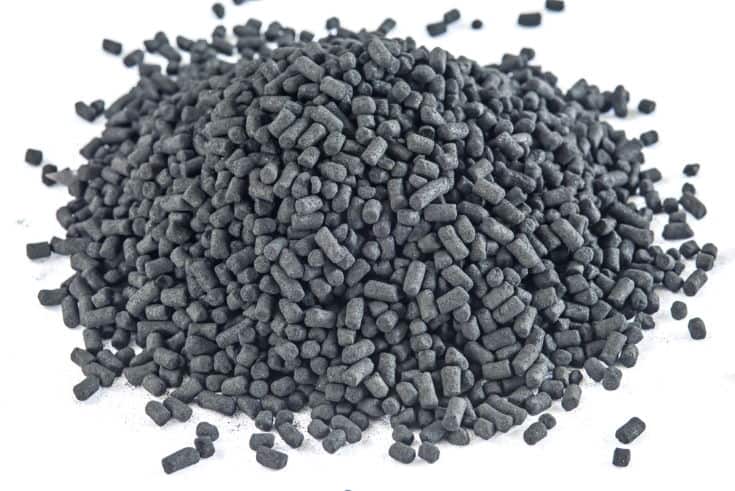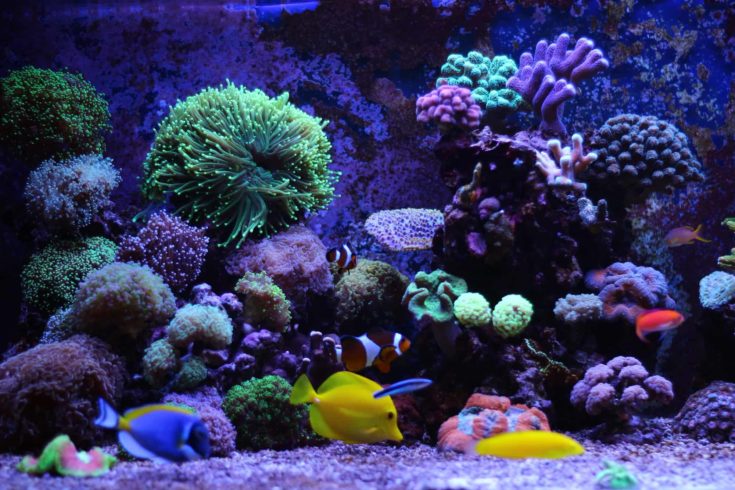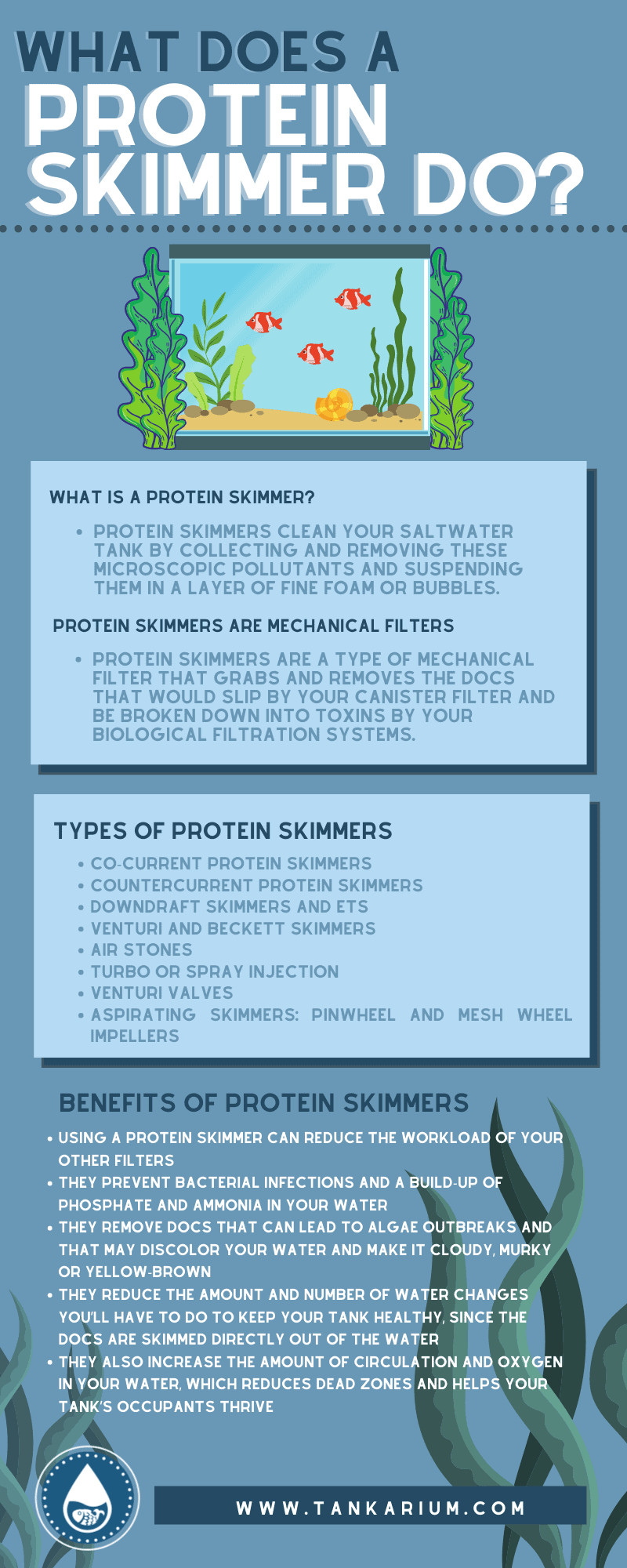When it comes to marine tanks one of the most important systems to have is a protein skimmer. Saltwater protein skimmers are helpful if you want to keep your marine animals healthy and your tank water clear and clean.
So, what does a protein skimmer do, exactly, and how do they work to filter your tank’s water? Read on to know more!
Guide To Protein Skimmers
Of all of the types of filtration, no other system is regarded with more skepticism by novices than the protein skimmer. You may wonder if you really need a device that looks like it was cobbled together from spare parts for your saltwater tank. Let’s take the mystery out of protein skimmers and explore how they function in your aquarium!
What Is A Protein Skimmer?
Protein skimmers can be a confusing product to research because it’s not obvious what they bring to the filtration game. Is protein really such a problem in saltwater aquariums that you have to filter it out?
Not exactly. It’s common for aquariums to develop a scum along the surface at the water line. The scum or biofilm is made up of tiny bits of lipids (fats), carbohydrates (sugar) and a little protein (amino acids) mixed with bacteria, algae and other organic and inorganic materials. This biofilm can quickly gunk up your tank and filters.
Protein skimmers clean your saltwater tank by collecting and removing these microscopic pollutants and suspending them in a layer of fine foam or bubbles. This leaves your water clearer, cleaner and safer for your fish and corals. They don’t target proteins specifically, but instead filter out the organic waste products in the water:

- Protein skimmers are also known as foam fractionators, foam separators or air-strippers, and these names much better describe their function.
- Skimmers collect and remove dissolved organic compounds (DOCs) floating in your tank’s water; there’s actually very little protein in an aquarium.
- While ocean water rarely has a high concentration of DOCs, they can build up quickly in a closed system like an aquarium.
How Does A Protein Skimmer Work?
What type of filtration is a protein skimmer, anyway, and how do they remove microscopic DOCs from your saltwater tank? While their size, shape and technologies may differ, all protein skimmers do the same essential job:
- Water is pumped from your tank or filter into a reaction chamber inside the skimmer.
- An injector or impeller mixes the water with air until extremely fine bubbles are formed.
- DOCs are attracted to the tiny air bubbles, and as the impeller spins the DOCs react with and stick to these bubbles, forming a fine, scummy foam filled with organic debris.
- The foam is collected in a cup on the top of the skimmer, where it can be discarded, and the clean water is returned to the sump filter or tank.
Basic Science Of Protein Skimming
Breaking down the science behind a protein skimmer’s function is a lot more complicated than explaining how they work, and unless you are a big fan of marine tanks or a science geek like myself, you may want to just accept that DCOs are drawn to the air bubbles and can be filtered out by foam fractionation.
This process is also used on an industrial scale in water treatment plants around the world. If you’d like to understand why protein skimmer’s work, however, I’ll cover the basics:
- Skimmers take advantage of the fact that large organic molecules have sections with different polarities or charges. Some sections are drawn to water molecules by their charge, and others are repelled by water (hydrophilic and hydrophobic).
- DOCs are amphipathic, which means each molecule has sections that are hydrophilic and sections that are hydrophobic. They differ from substances like grease, which are entirely hydrophobic and uniformly repel water.
- These amphipathic molecules are the primary targets of a protein skimmer based on their chemistry and how they react to the air and water inside the device.

- Aquariums don’t have a lot of surface area compared to their volume and can’t naturally create enough bubbles to capture the DOCs floating in the tank water, although they can develop a DOC-rich scum near the filter outflows.
- When mixed in the skimmer’s reaction chamber, the DOCs can be separated from the water by taking advantage of their partial attraction to air and filling the chamber with fine bubbles.
- The hydrophobic parts of the DOCs are drawn to the minuscule air bubbles created by the impeller and get “stuck” to the bubbles by surface tension.
- As the bubbles rise in the chamber, they drag the DOCs with them until most of the water is left behind and all that’s left is a dirty foam that collects in the upper cup.
Protein Skimmers Are Mechanical Filters
How are DOCs different from the waste products removed by other types of filters? While typical aquatic filters such as HOBs and canister systems use fine woven pads, sponges and other materials like cotton wadding to mechanically strain out larger particles of waste from your water, they leave a lot of microscopic bits behind.
Filters with media such as carbon, ammonia chips or phosphate absorbers can reduce the levels of toxins in your tank, but they absorb the toxins after the good aquatic bacteria have broken the waste products down. A protein skimmer removes DOCs before they are converted into these toxins.

Protein skimmers are a type of mechanical filter that grabs and removes the DOCs that would slip by your canister filter and be broken down into toxins by your biological filtration systems. Supplementing your filtration with a protein skimmer reduces the workload and maintenance requirements of your other systems.
Types Of Protein Skimmers
There’s many different ways protein skimmers may be classified, and as technology advances and more hybrid systems come to market, an increasingly large number of unique products have added to the confusion. I think the easiest way to distinguish between them is to consider how water circulates through the different systems.
Water Circulation In Different Types Of Protein Skimmers
There are two primary types of protein skimmers and about four current methods used to inject air and water into their reaction chambers. It’s not unusual to find skimmers with mixed features, such as a Beckett skimmer with a Venturi valve and pinwheel impeller. Let’s start by looking at how water flows through them.
Co-Current Protein Skimmers
Co-current protein skimmers are the simplest and oldest type, and work by sending a stream of fine bubbles up through the water column to capture the DOCs. The original version of protein skimmers use an air stone in the bottom of a tall reaction chamber or PVC pipe filled with the aquarium water and can be easily DIY’d at home:
- Air pumped into the stone forms tiny bubbles which are released into the lowest part of the water column.
- As the bubbles rise through the dirty water, the DOCs stick to the bubbles and are drawn up with them.
- A fine mix of scum and foam collect in the top of the reaction chamber where they can be skimmed off.
Countercurrent Protein Skimmers
Co-current skimmers work, but they require a tall reaction chamber to ensure the bubbles have enough contact time with the water to grab the DOCs. Many aquarists prefer not to have a 7-foot tall PVC pipe standing next to their tank. A more compact and efficient type is the countercurrent protein skimmer:
- Air is injected into the bottom of the reaction chamber under high pressure while water is pumped in under pressure from the top of the chamber.
- The water moves down the chamber against the flow of the air bubbles; hence the term “countercurrent,” since the water is moving against the current of bubbles.
- The injection creates a finer mix of bubbles of the optimal size to capture pollutants (depending on which injection methods are used).
- It also ensures the bubbles spend the maximum amount of time in contact with the water for the highest performance and efficiency.
Downdraft Skimmers And ETSs
Two older styles of countercurrent skimmers are the unique downdraft skimmer and a more modern version known as the ETS (environmental tower system).
- These systems spray or inject your tank water at a high speed through a network of tubes filled with foam or bio balls, creating a fine mist of bubbles.
- The bubbles are pushed down into a separate chamber, where they react with and collect the DOCs from the water.
- The scummy foam is pushed to the upper collection cup, where it can be discarded.
These skimmers were popular at the time because they were smaller and more efficient than the co-current types and could handle the higher flow rates needed to clean large marine tanks. You don’t see them very often on hobby tanks anymore, although professional aquariums still use them.
Venturi And Beckett Skimmers
You’ll often run across the terms “Venturi” and “Beckett head” as you research countercurrent protein skimmers. Instead of spraying water at high pressure into a tube of bio balls, Venturi and Beckett skimmers use a modified valve and nozzle to create foam inside the reaction chamber.
The Venturi and Beckett skimmers had a huge impact on the hobby trade and the design of modern protein skimmers, although it’s rare to see the old models still in action. But their main technological breakthroughs were borrowed by other manufacturers and are still used in most skimmers today:
- The Venturi valve is now found on most countercurrent protein skimmers, even systems that use impellers to chop the water into finer bubbles (see below)
- This special valve creates foam by mixing water and air together under high pressure.
- When combined with a strong pump and nozzle, Venturi valves produce tremendous amounts of foam, even in compact skimmers.
- The Beckett head nozzle relies on the Venturi valve and increases the amount of air (and thus, filtration power) incorporated into the foam.
- Beckett head nozzles dramatically increase the amount of water that can be processed by a protein skimmer and are still used in many industrial settings and by professional aquariums.
- As pinwheel and other types of injector systems become more popular in the hobby market, Beckett heads are less commonly seen in home protein skimmers.
Method Of Injection In A Protein Skimmer
I’ve mentioned that there are many methods of injecting air and saltwater into a chamber and mixing them up to form bubbles. Let’s take a look at some of these methods and how they are used in modern protein skimmers:
Air Stones
Air stones were the original method of mixing air and water in a simple co-current skimmer, and they are still used for this purpose and in aquariums in general for increasing the water’s oxygen saturation. Air stone-based skimmers are some of the simplest and easiest types to use and maintain, but they do require replacement.
Oddly enough, the air stones used in protein skimmers are not stone at all, but actually a fine type of wood. Air is forced by a pump into a limewood or basswood “stone,” and as the air moves through the wood grain tiny bubbles form on the surface and bubble up through the chamber.
Turbo Or Spray Injection
While folks usually associate spray injectors with the downdraft skimmers, other types also rely on powered or turbo injectors to push water into a countercurrent skimmer’s reaction chamber under high pressure.
The Beckett head nozzle is a modified version of a spray injector, for instance, and they’re often combined with other systems to produce the maximum amount of foam. As pinwheel impellers and other air-shredding systems become more popular they’ve often replaced the older spray injector systems.
Venturi Valves
Venturi valves force water entering the skimmer into a narrow tube, which increases the water pressure. A second offset valve allows air to mix with the water, creating a fine mix of foamy bubbles. Most protein skimmers use Venturi valves as the introductory step of bubble creation, even if they also use a wheel or impeller.
Aspirating Skimmers: Pinwheel And Mesh Wheel Impellers
A newer and very popular method of injection uses needles or a mesh wheel to turn the air entering the skimmer into fine bubbles. These aspirating skimmers get their names from the appearance of the impeller, whether it’s a spinning “pinwheel” with needles sticking out from the center or a mesh screen that shreds the air as it turns.
A big advantage of these new protein skimmers is they produce large numbers of very fine bubbles, especially when used with a Venturi valve. The pump doesn’t have to work as hard to push the air and water mixture as it would pushing water alone, so they are more compact and quieter than older skimmers.
Benefits Of Protein Skimmers
Now that you know all the details about how they work and how they have evolved from simple into complex devices, let’s summarize the benefits of using a protein skimmer in your marine or reef tank:
- Using a protein skimmer can reduce the workload of your other filters and lowers the amount of maintenance they require.
- They prevent bacterial infections and a build-up of phosphate and ammonia in your water.

- They remove DOCs that can lead to algae outbreaks and that may discolor your water and make it cloudy, murky or yellow-brown.
- They reduce the amount and number of water changes you’ll have to do to keep your tank healthy, since the DOCs are skimmed directly out of the water.
- They also increase the amount of circulation and oxygen in your water, which reduces dead zones and helps your tank’s occupants thrive.
While they can be used for freshwater set-ups as well, the technology isn’t very advanced yet and is quite complicated and expensive to set up. I don’t think I’ve ever seen one outside a professional aquarium. You don’t have to use a skimmer on your marine tank, but it’s a great way to supplement your other filtration systems!
Disadvantage Of Using Protein Skimmers In Reef Tanks

There are special challenges that come with using protein skimmers in reef tanks. Corals and other filter-feeders rely on phytoplankton for food, so using a protein skimmer 24/7 could create starvation conditions in your tank. You might only want to run a skimmer for a few hours a day to avoid stripping your reef of all its food supply.
Conclusion
Micro protein skimmers collect and remove the dissolved organic compounds in your marine water. Using a protein skimmer is an easy way to reduce the amount of work it takes to maintain your tank. You won’t have to do as many water changes, and your other filtration systems will work more efficiently as well!
I hope you’ve enjoyed this introduction to protein skimmers, and I’d love to hear what you chose for your saltwater tank! Share your thoughts below in the comments, or join us for the fun on our social media pages.
Check out our infographic and don’t forget to share!

